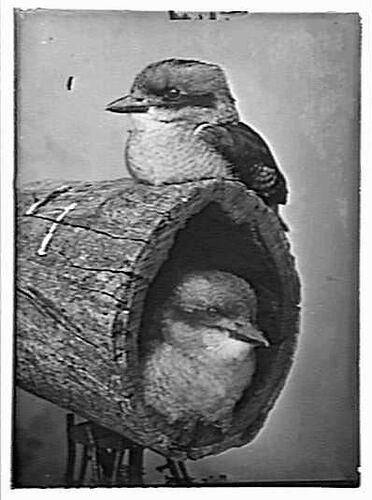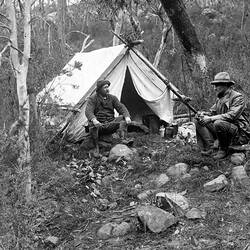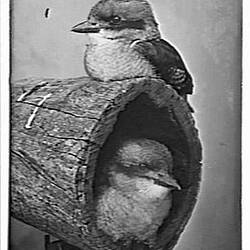BROWN KINGFISHER (LAUGHING JACKASS)
Dacelo Gigas, Boddaert - (60)
Geographical Distribution - South Queensland, New South Wales, Victoria, South and West (intro-duced 1896) Australia.
Nest - In a hole or spouted limb of a tree; but is sometime, especially in Queensland, in a hole drilled into the nest of ants or termites situated in a fork or upon the side of a standing tree. An instance is known of a net made in the heart of a 'calabash' - the fern, Platycerium alcicorne.
Eggs - Clutch, three to four; round in shape, sharply contracted at one end; texture of shell fine; surface glossy; colour, pure white. Dimensions in inches of a clutch: (1) 1.92 x 1.45, (2) 183 x 1.5, (3) 1.83 x 1.42.
Observations - The Great Brown Kingfisher (native name Kookaburra), or more commonly called Laughing Jackass, from its quaint appearance and its rollicking laughter-like notes, is not only a favour-ite among naturalists, but with every dweller in the bush. The adult Laughing Jackass has a dusky back and wings, some parts of the wings, especially the shoulders, also the lower portion of the back, being relieved with markings of blue. The tail is brownish, barred with black. The rest of the plumage may be termed buff, with a dark-brownish wash on the feathers of the head and ear coverts. The awkward-looking bill is brownish-black on the upper mandible, and yellowish or pale buff on the under mandible, while the eyes are dark-brown, and the feet yellowish. The total length of the bird is about 18 inches, including tail 5 ½ inches, and bill 3 inches.
Amongst the most cheerful of forest sounds at evening are this bird's notes when heard among lofty trees up some gully. Then again at early dawn, soon after the chirping notes of the Yellow Robin and sometimes before the melodious Magpie, the voices of the Jackasses herald the coming day. On two mornings I timed the Jackass's first song at 4.20, or just one hour before sunrise. Again at evening it is delightful to listen to these birds in the bush, when they are particularly noisy. But all settle down quietly as the last light of the day fades out. It has been stated that the female only voices the laughter-like notes, while the male accompanies her with the growling noise. Is it a fact?
Until recent years the Great Brown Kingfisher did not appear to exist in Western Australia - I refer more particularly to the forests of the south-west, which would appear equally as well adapted to the peculiar habits of the bird as the eastern timber tracts are. However, Mr. G. A. Keartland, of the Calvert ex-pedition in 1896, stated whilst camped at Mullawa he heard the well-known notes of these birds, and ob-served a few of them always near the camps. They were also noted between Fremantle and Perth. Perhaps these latter were some of the birds captured in Victoria by Mr. James Cooper, and sent to Western Australia by order of the Government, or perhaps the Jackasses had followed the numerous other eastern 'Jackasses' who had been attracted to the glorious west by the wonderful gold discoveries. The Brown Kingfisher being the southern form of the genus Dacelo, I was agreeable sur-prised, in 1885, to find the bird as far north as the Cardwell Scrubs, North Queensland. Since then, Mr. Dudley Le Souëf informs me he noted the bird on the Bloomfield River, still further north. It has been observed in the interior at Cooper's Creek.
The chief breeding months of the Brown Kingfisher are from September to the end of the year, during which period usually two broods are reared. In Southern Queensland Mr. Lau observed that the first clutch was generally laid in September, and the second in November. The nesting place is not lined in any way; the eggs are merely deposited on the dust of the decomposed wood in the hollow, or, if in termites' nests, on the bare floor at the end of the tunnel. Old nests are sometimes resorted to; but if new quarters have to be found, both male and female birds assist in excavating the hole.
On October 31st (1893), Mr. George H. Morton took three eggs from the spout of a red-gum tree, five feet from the ground, near the Murray River. On November 27th, he found a young bird in the same nest. When Mr. Morton removed the three eggs he may have left one remaining, but the greater prob-ability is the fourth egg was laid afterwards. However, on the 12th December the young had left the nest. Therefore we may infer that from the time the female deposits her eggs till the young quit the nest is about six weeks.* After the young leave the nest their parents continue to feed them for a time. By their clamorous noise for food the whereabouts of the young is easily ascertained.
In my note-book I find the following recorded:
9th November, 1870 - Visited a nest, containing three young, in the hole of a tree near Dandenong Creek.
11th October, 1880 - Found an egg fresh upon the ground near Berwick
13th October, 1885 - Present when a pair of eggs was taken from termites' nest at Coomooboolaroo, Queensland.
1st November, 1890 - Clutch, three eggs, taken at Clayton, Victoria.
6th November, 1892 - Observed nest with young, Murray River.
Jackasses have been observed gathering mussels (Unio) at the edge of a creek, and whacking them against a log or limb endeavouring to open them; they will also dive for small cray-fish. Mr. C. H. McLennan tells me he has observed these birds perching on a limb just over the river (Wimmera) and diving into shallow water after yabbies (small crayfish), sometimes going right under.
No doubt the Jackasses only kill snakes for food, because dead ones are occasionally found in their nesting holes. Mr. A. W. Milligan, formerly of Traralgon, Victoria, also proved the fact by taking young Jackasses from a nest in the vicinity of his home and keeping them on a cage. When the old birds found out the captives, they sometimes brought, amongst other tit-bits, snakes, and large ones too, to feed their young.
In reference to Jackasses killing snakes, Mr. H. W. Wheelwright observed a pair that had a disabled carpet snake under an old gum tree. The birds sat on a dead branch above the reptile, every now and again darting down and pecking it, and by their antics and chattering appeared to considerably enjoy themselves at the expense of the snake
Mr. Thos. R. Macdougall's (Queensland) field observations on 'Jackasses v. Snakes,' read:-
'On one occasion I saw a Jackass with a black snake about twelve inches or eighteen inches in length. On frightening the bird it dropped the snake, and I carefully examined it and found that it had not been long dead, and was only wounded behind the head. Its neck was broken. I also saw on one occasion a Jackass and green snake that had been killed while on the ground. The snake was coiled tightly around the bird's neck and body, so that it could not rise from the ground.'
*I possess a pair of live Jackasses that was taken from a nest when the birds were about a month old. At the age of six weeks one endeavoured to laugh, and both could laugh loudly and lustily before they were three months old.
Resources
Transcribed Archibald James Campbell. Nests and Eggs of Australian Birds, including the Geographical Distribution of the Species and Popular Observations Thereon, Pawson & Brailsford, Sheffield, England, 1900. Transcribed from pp. 304-305.
More Information
-
Keywords
-
Authors
-
Contributors
-
Article types




